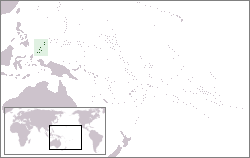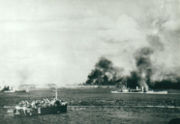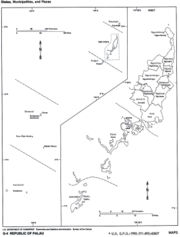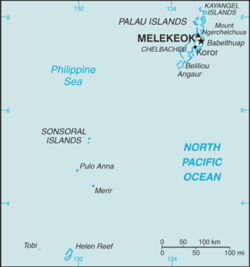Palau
2007 Schools Wikipedia Selection. Related subjects: Geography of Oceania (Australasia)
| Beluu er a Belau パラオ共和国 Republic of Palau |
|||||
|
|||||
| Motto: Rainbow's End | |||||
| Anthem: Belau loba klisiich er a kelulul | |||||
| Capital | Melekeok1 |
||||
|---|---|---|---|---|---|
| Largest city | Koror | ||||
| Official languages | English, Palauan, Japanese (in Angaur) | ||||
| Government | Constitutional government in free association with the USA |
||||
| - President | Tommy Remengesau | ||||
| Independence | from UN Trust Territory | ||||
| - Date | October 1, 1994 | ||||
| Area | |||||
| - Total | 459 km² ( 195th) 177 sq mi |
||||
| - Water (%) | negligible | ||||
| Population | |||||
| - July 2005 estimate | 19,949 ( 217th) | ||||
| - Density | 43/km² ( 155th) 111/sq mi |
||||
| GDP ( PPP) | 2001 estimate | ||||
| - Total | $174 million2 ( not ranked) | ||||
| - Per capita | $9,000 (2001 est.) ( not ranked) | ||||
| HDI (2003) | n/a (unranked) ( n/a) | ||||
| Currency | US Dollar ( USD) |
||||
| Time zone | ( UTC+9) | ||||
| Internet TLD | .pw | ||||
| Calling code | +680 | ||||
| 1 On 7 October 2006, government officials moved their offices in the former capital of Koror to Melekeok, located 20 km northeast of Koror on Babelthaup Island. 2 GDP estimate includes US subsidy (2001 est.) |
|||||
Palau, officially the Republic of Palau, is an island nation in the Pacific Ocean, some 500 miles (800 km) east of the Philippines. Having emerged from United Nations trusteeship (administered by the United States) in 1994, it is one of the world's youngest and smallest nations. It is sometimes referred to in English under its native name Belau.
History
Archeology
Early Palauans may have come from Australia, Polynesia and Asia. Depending on the thread of the family, Palauans may indeed represent many parts of Melanesia, Micronesia and Polynesia. However, it is traditionally considered to be Melanesian. According to geneticists- there are two distinctive strains of Melanesian bloodlines: one is associated with indigenous Australians/Papua New Guineans and the other is known to have originated in Asia. There has not been any link established between the two.
Until recently, Palau was not considered a part of Micronesia. In the European and Australian world Belau/Pelew is better known by the name of "The Black Islands". Vintage maps and village drawings can be found at the Australian library online. There you will see photos of the tattooed and pierced Ibedul of Koror and Ludee.
Carbon dating and recent archeological discoveries have brought new attention to the archipelago. Cemeteries uncovered in islands have shown Palau has the oldest burial ceremony known to Oceania. Prior to this there has been much dispute as to whether Palau was established during 2500 BC or 1000 BC. New studies seem to dispute both of these findings. Moreover, Palau's ancient trading partner, Java, has also come under close scrutiny since homo floresiensis was found.
Interestingly, Java is where traditional female Palaun money originated. Carrying on the family line, Palauan women have always been embellished with land, titles and money. For thousands of years, Palauans have had a well established matrilineal society.
European contact
Historians take much interest in the navigational routes of European explorers. One such mystery has created much speculation as to whether Spanish explorer Ruy López de Villalobos spotted the islands in 1543. No conclusive evidence exists but there are some who think he could have seen the tip of a southern most island in the group.
Palau was one of the last of the South Sea islands to be discovered - not only due to a lack of navigation skill but because neighboring islands knew nothing about Melanesia. Palau had limited relations - mainly with Yap and Java.
Had it not have been for ship-wrecked islanders who accidentally took refuge in the Philippines, Europeans likely would not have found a route to Palau until much later. Palau's first Western contact took place when English Captain Henry Wilson also shipwrecked off the island of Ulong in 1783. Wilson dubbed Palau the “Pelew Islands”.
The Spanish claimed Palau as part of the Spanish East Indies, and was governed from the Philippines, until the emergence of 1875 British protests.
In 1885, after Germany occupied some of the islands, a dispute was brought to Pope Leo XIII, who made an attempt to legitimize Spanish claim to the islands (but with economic concessions for Britain and Germany). Spain in 1899, after defeat during the Spanish-American War, sold the islands to Germany.
In 1914 Japan invaded the islands, then formally took over under the Treaty of Versailles after the WWI German defeat. Over three decades the Japanese enforced cultural change. Introduction of an exclusive market economy geared towards Japanese citizens temporarily revoked tribal ownership. Although some reparation was made, defeat did not restore complete order. US intervention only served to widen the legal semantics needed to recover from such an event spanning three different countries with three different tongues.
Peleliu was the scene of a costly battle between American and Japanese forces in 1944, resulting in an Allied victory, though the cost in human terms was high for both sides. After WWII the United Nations played a role and it was decided the US would administer Palau as part of the Trust Territory of the Pacific Islands. Eventually, in 1979 Palauans voted against joining the Federated States of Micronesia based on language and cultural differences. After a long period of transition, including the violent deaths of two presidents ( Haruo Remeliik in 1985 and Lazarus Salii in 1988), Palau voted to freely associate with the United States in 1994 while opting to retain independence under the Compact of Free Association.
There are still roughly 100 American service members listed as Missing In Action (MIA) in Palau since WWII. Since 1993, a small group of American volunteers called The BentProp Project have searched the waters and jungles of Palau to attempt to locate information that can lead to the identification and recovery of remains of these American MIAs.
Government
Politics of Palau takes place in a framework of a presidential representative democratic republic, whereby the President of Palau is both head of state and head of government, and of a pluriform multi-party system. Executive power is exercised by the government. Legislative power is vested in both the government and the Palau National Congress. The Judiciary is independent of the executive and the legislature.
Foreign relations
Palau gained its independence October 1, 1994 with the entry into force of the Compact of Free Association with the United States. Palau was the last Trust Territory of the Pacific Islands territories to gain its independence. Under the Compact, the U.S. remains responsible for Palau's defense for 50 years.
Palau is a sovereign nation and conducts its own foreign relations. Since independence, Palau has established diplomatic relations with a number of nations, including many of its Pacific neighbors. Palau was admitted to the United Nations on December 15, 1994, and has since joined several other international organizations.
States
Palau is divided into sixteen states (until 1984 called municipalities):
|
|
The uninhabited Rock Islands of Palau, next to Koror, are not part of any of the sixteen states. Although it lies between the state of Koror and the State of Peliliu, both states lay claim over its territorial boundaries.
Geography
Palau's most important islands are Angaur, Babeldaob, Koror, and Peleliu. The latter three lie together within the same barrier reef, while Angaur is an Oceanic Island several miles to the South. About two-thirds of the population lives on Koror. The coral atoll of Kayangel is situated north of these islands, while the uninhabited Rock Islands (about 70) are situated to the west of the main island group. A remote group of six islands, known as the Southwest Islands, some 375 miles (600 km) from the main islands, are also part of the country.
Climate
Palau enjoys a tropical climate all year round with an annual mean temperature of 82 ° F (27 ° C). Rainfall can occur throughout the year, averaging a total of 150 inches (3,800 mm). The average humidity over the course of the year is 82%, and although rain falls more frequently between July and October, there is still much sunshine. Typhoons are rare, as Palau is outside the main typhoon zone.
Environment
While much of Palau's fragile natural environment remains free of environmental degradation, there are several areas of concern, including illegal fishing with the use of dynamite, inadequate facilities for disposal of solid waste in Koror, and extensive sand and coral dredging in the Palau lagoon. Like the other Pacific island nations, a major environmental problem is global warming and the related rising of sea level. Water coverage of low-lying areas is a threat to coastal vegetation, agriculture, and the purity of the nation's water supply. Palau also has a problem with inadequate water supply and limited agricultural areas to support the size of the population. The nation is also vulnerable to earthquakes, volcanic activity, and tropical storms. Sewage treatment is a problem, along with the handling of toxic waste from fertilizers and biocides.
Gallery
Economy
The economy consists primarily of tourism, subsistence agriculture, and fishing. Tourist activity focuses on scuba diving and snorkeling in the islands' rich marine environment, including the Floating Garden Islands to the west of Koror and the Rock Islands to the south. The government is the major employer of the work force, relying heavily on financial assistance from the US. Business and tourist arrivals numbered 50,000 in the financial year 2000/2001. The population enjoys a per capita income twice that of the Philippines and much of Micronesia. Long-term prospects for the key tourist sector have been greatly bolstered by the expansion of air travel in the Pacific, the rising prosperity of leading East Asian countries, and the willingness of foreigners to finance infrastructure development.
In July of 2004, Palau Micronesia Air was launched with service from Palau to Yap, Guam, Micronesia, Saipan, Australia, and the Philippines. It was thought of giving Continental Micronesia a run for its money due to the low fares which it offered to its passengers, however it has ceased operations in December of the same year and has not restarted operations since.
Demographics
The population of Palau is approximately 19,000 of whom 70% are native Palauans, who are of mixed Melanesian, Micronesian, and Polynesian descent. Filipinos form the second largest ethnic group. Other Asians and Europeans account for the minority groups.
Two thirds of the population are Christians (mainly Catholics and Seventh-day Adventists), but Modekngei (a combination of Christianity, traditional Palauan religion and fortune telling) and the ancient Palauan religion are still the most commonly observed household religions.
The official languages of Palau are Palauan and English, except for two states (Sonsorol, Hatohobei) where the local language along with Palauan, is official.





















